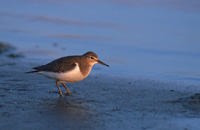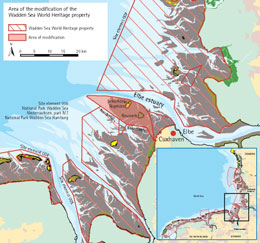Hamburg Wadden Sea now also listed as World Heritage Site
 Bonn,
Bonn,
30 June 2011 - The Hamburg Wadden Sea was added to
the List of World Heritage Sites by the UNESCO World Heritage
Committee at its annual meeting in Paris on 27 June 2011.
The Hamburg Wadden Sea National Park now closes the gap
between the Dutch and German Wadden Sea which was already
declared a World Heritage Site in 2009.
The new site is about 137 km² and
covers 1.4% of the whole Wadden Sea World Heritage property
of almost 10,000 square kilometres encompassing the Dutch
Wadden Sea Conservation Area and the German Wadden Sea National
Parks of Lower Saxony and Schleswig-Holstein - now also
including the Hamburg National Park.
 Hamburg
Hamburg
did not apply for World Heritage Site status for its section
of the park in 2009 because the city-state authorities feared
that the award could prevent them from carrying out plans
to deepen the Elbe. After reviewing the request, the UNESCO
committee confirmed their tolerance of an expansion of shipping
lanes along the river and later on granted World Heritage
Site status, thus ensuring the future protection of the
Hamburg Wadden Sea.
The Wadden Sea is considered to be one
of the most important wetlands for migratory waterbirds
worldwide. Many waterbird species using the East Atlantic
Flyway, such as the Red Knot (Calidris canutus),
the Bar-tailed Godwit (Limosa lapponica) and the
Curlew (Numenius arquata), depend upon the area’s
uniquely varied landscape of inter-tidal mudflats, salt
marshes and sand banks both as a major stop-over site to
refuel for their long journeys between their breeding and
wintering areas, or as a wintering site.
In addition to being a breeding and wintering
area for up to 12 million birds per year, the Wadden Sea
provides habitats for more than 10,000 plant and animal
species, including marine mammals such as the harbour seal,
grey seal and the harbour porpoise.
For more information please visit:
- Wadden Sea World Heritage Site Website: www.waddensea-worldheritage.org
- AEWA
Announcement (26 June 2009): Wadden Sea listed as World
Heritage Site
Last updated on 16 June 2014


